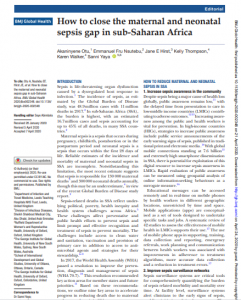
Introduction
Sepsis is life-threatening organ dysfunction caused by a dysregulated host response to infection.1 The incidence of sepsis, as estimated by the Global Burden of Disease study, was 48.9 million cases with 11 million deaths in 2017.2 In sub-Saharan Africa (SSA), the burden is highest, with an estimated 16.7 million cases and sepsis accounting for up to 45% of all deaths, in many SSA countries.2
Maternal sepsis is a sepsis that occurs during pregnancy, childbirth, postabortion or in the postpartum period and neonatal sepsis is a sepsis that occurs within the first 28 days of life. Reliable estimates of the incidence and mortality of maternal and neonatal sepsis in SSA are incomplete. Notwithstanding this limitation, the most recent estimate suggests that sepsis is responsible for 130 000 maternal deaths3 and 300 000 neonatal deaths annually, though this may be an underestimate,4 in view of the recent Global Burden of Disease study report.2
Sepsis-related deaths in SSA reflect underlying political, poverty, health inequity and health system challenges across Africa.5 These challenges affect preventative and public health efforts to prevent sepsis and limit prompt and effective recognition and treatment of sepsis to prevent mortality. The challenges include access to clean water and sanitation, vaccination and provision of primary care in addition to access to antimicrobial agents and strategies for their stewardship.6–9
In 2017, the World Health Assembly (WHA) passed a resolution to improve the prevention, diagnosis and management of sepsis (WHA 70.7).10 This resolution recommended key action areas for member states and future priorities.11 Based on these recommendations, we outline nine key areas to accelerate progress in reducing death due to maternal and neonatal sepsis in SSA.